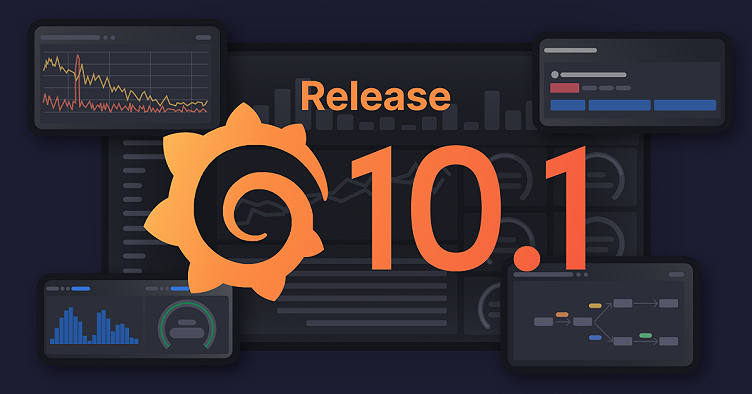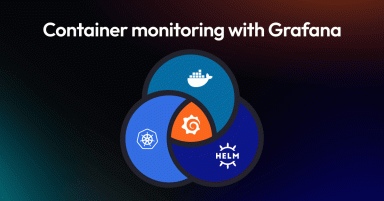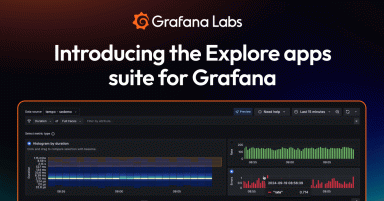
Grafana 10.1 release: Enhanced flame graphs, new geomap network layer, and more
Grafana 10.1 is here! The latest Grafana release introduces new features and improvements that help deepen your observability insights in Grafana, including an improved flame graph, a new geomap network layer, simplified alerting workflows, and more.
For an overview of all the features in this release, check out our What’s New documentation. And to learn the details about all the Grafana 10.1 updates, read our changelog for more information.
Let’s dive into what’s new in Grafana 10.1!
Find resource-heavy functions with flame graph improvements
Generally available in all editions of Grafana
Identifying resource usage in your code for debugging or optimizing your infrastructure spend can be tricky. With the revamped flame graph visualization for continuous profiling in Grafana, you can now have a more detailed view into your application performance.
The new sandwich view provides a comprehensive overview of symbols, showing both callers and callees. You can also customize your view with adjustable color schemes and symbol name alignments. Enhanced navigation features, including a status bar and table-based symbol highlighting, ensure that you can pinpoint and analyze critical data points.
There’s supposed to be a video here, but for some reason there isn’t. Either we entered the id wrong (oops!), or Vimeo is down. If it’s the latter, we’d expect they’ll be back up and running soon. In the meantime, check out our blog!
Visualize your network’s spatial distribution with the Geomap network layer
Available in public preview in all editions of Grafana
When dealing with node graphs that incorporate geospatial data, having a visual representation of your network on a map can offer invaluable insights. This spatial context enhances your ability to monitor the status of nodes and the relationships between them.
In the current geomap setup in Grafana, the only available method to draw lines between points is using a route layer, which requires that points are ordered sequentially. Each connection between nodes also needs its own layer, query, and/or transformation. Additionally, representing nodes would require a separate markers layer.
Enter the new geomap network layer.
This enhancement allows you to define your nodes with specific geospatial data and establish connections without the need for sequential ordering, multiple layers, or transformations. By integrating both nodes and connections within a single framework, the geomap network layer simplifies data input, reduces the need for multiple queries, and presents a unified visual representation of your network.
As a result, building out a network map becomes not only more practical, but it also provides more precise insights into your network’s structure and performance.
There’s supposed to be a video here, but for some reason there isn’t. Either we entered the id wrong (oops!), or Vimeo is down. If it’s the latter, we’d expect they’ll be back up and running soon. In the meantime, check out our blog!
Disconnect values for improved data accuracy in dashboards
Generally available in all editions of Grafana
When you’re visualizing data in time series, trend, and state timeline panels, one challenge you might have faced is when arbitrary gaps in your data end up automatically connected in your visualization. For example when sensors or other IoT devices that report at regular intervals no longer respond, but your line graph doesn’t represent a point of failure. This can distort the true picture of your data, leading to potential misinterpretations.
Now you can set a specific threshold on the x-axis in your Grafana dashboards. Any data points above this threshold will be disconnected. This ensures that if, for example, a sensor doesn’t respond within the expected interval, the visualization won’t misleadingly connect the data.
There’s supposed to be a video here, but for some reason there isn’t. Either we entered the id wrong (oops!), or Vimeo is down. If it’s the latter, we’d expect they’ll be back up and running soon. In the meantime, check out our blog!
Trace analysis with span filtering
Generally available in all editions of Grafana
When working with traces, especially those comprising a vast number of spans, pinpointing specific spans of interest can be a daunting task. This is where span filtering comes in. Located above the trace view, span filters allow you to refine the spans displayed based on specific criteria. Whether you’re looking to identify spans from a certain service, those exceeding a particular duration, or spans tagged with specific attributes, span filtering streamlines the process.
You can set multiple filters, such as:
- Service name
- Span name
- Duration
- Tags (including process tags and log fields)
For a more focused view, the Show matches only toggle ensures only the spans meeting your criteria are displayed. This is particularly useful when sifting through thousands of spans, allowing you to zero in on those that truly matter. For instance, if you’re keen on understanding why a specific request is lagging, or if you’re on the hunt for spans without a certain tag, span filtering is your go-to tool. It even lets you search for spans based on specific tag keys, like cluster.
There’s supposed to be a video here, but for some reason there isn’t. Either we entered the id wrong (oops!), or Vimeo is down. If it’s the latter, we’d expect they’ll be back up and running soon. In the meantime, check out our blog!
Improved query efficiency with TraceQL response streaming
Experimental in all editions of Grafana
Working with large datasets often means waiting for extended periods as queries process. Grafana introduces an experimental feature for trace visualizations: TraceQL response streaming. This enhancement allows you to view partial results of your TraceQL queries in real time. That means no more waiting for extensive queries to complete before seeing your results (even in Search).
To activate this feature, simply toggle on the traceQLStreaming option. If you’re using Grafana Cloud and you’re interested in accessing this functionality, please reach out to our customer support team.
There’s supposed to be a video here, but for some reason there isn’t. Either we entered the id wrong (oops!), or Vimeo is down. If it’s the latter, we’d expect they’ll be back up and running soon. In the meantime, check out our blog!
Distinguish widgets from visualizations for building better dashboards
Experimental in all editions of Grafana
We have separated two primary panel plugin types in Grafana: visualization panels, which are linked to a data source, and widgets that function autonomously.
This update will improve your dashboard creation process because if you want to integrate elements like text, news, or an annotation list, you no longer need to select a data source first. Plus, to optimize your editing experience, the plugins list and library panels are now context-aware, adjusting in real time based on whether you’re working with a widget or a visualization.
There’s supposed to be a video here, but for some reason there isn’t. Either we entered the id wrong (oops!), or Vimeo is down. If it’s the latter, we’d expect they’ll be back up and running soon. In the meantime, check out our blog!
New alert rule creation workflow in Grafana Alerting
Generally available in all editions of Grafana
You may have built an alert rule with Grafana Alerting and then grappled with routing, reconfiguring, and managing the different alerts your team set up. To address this challenge, we’ve implemented a series of improvements to alert rules.
- Clarification of alert rule types: We have clearly defined two primary alert rule categories: those managed by Grafana and those managed by a data source. This distinction aims to simplify your user experience, facilitating a more logical and systematic approach to alert rule creation and management.
- Alert instance routing preview: For those using Grafana-managed alert rules, you can now preview the alert route in real time. This ensures that your alerts are directed as you intended, giving you a higher degree of confidence in your configurations.
- UI refinements: The user interface has undergone modifications to streamline the alert rule creation process further. Noteworthy changes include a more structured display for queries and expressions, direct linking to dashboard and panel names, and an integrated YAML view for alert configurations. Furthermore, in-app guidance has been incorporated, offering you interactive assistance and valuable context during the alert rule creation phase.
There’s supposed to be a video here, but for some reason there isn’t. Either we entered the id wrong (oops!), or Vimeo is down. If it’s the latter, we’d expect they’ll be back up and running soon. In the meantime, check out our blog!
Learn more about Grafana 10.1
For a comprehensive overview of all the latest updates, refer to our Grafana documentation, changelog, or our What’s new documentation.
You can also join the conversation on our Grafana Labs community forums. Share your thoughts on the new features, discuss best practices, and explore innovative ways to integrate these updates into your dashboards and visualizations.
Upgrade Grafana now
Download Grafana 10.1 today or explore all the new features on Grafana Cloud, which offers a generous forever-free tier and tailored plans to suit every requirement. Start visualizing your data with Grafana Cloud for free today!
For guidance on upgrading your current Grafana setup, please refer to our upgrade guide.
A heartfelt thank you!
A massive shout-out goes out to our dedicated Grafana community. Your contributions — from PRs to feedback — play a pivotal role in making Grafana better with each release. Your passion and commitment also drive our teams at Grafana Labs to always innovate and improve.



